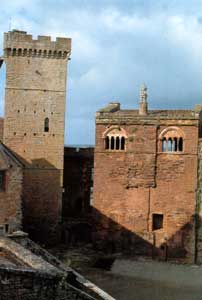

Ariège |
Gers |
Hautes Pyrénées |
Lot |
Tarn |
Other regions & other castles |
Previous months’ selections |
| Castelnau Bretenoux Castle |
|
|
Inside a large enclosure in flanked terrace of bastionnés turns and the projecting ones, the castle itself assigns a roughly triangular plan to six turns; essence dates from XVe-XVIe centuries. It however preserves distinguished remainders of the previous times. 1 - The turn-residence or "Audience", and the main tower The oldest element
is a residential building of 8 X 11 meters, in the shape of turn,
located on the face 0uest. Above two levels bored in XVIe century,
large bays probably replacing small windows, the noble stage lights
by five splendid bays with open-type screen, divided into four by
pretty posts wit 2 - The remainder of the castle Two other elements testify to the progressive construction of the châ teau out of stone: turn-carries of entry, first half of XIVe century, preceded at the next century by a curious external harrow, and the vault prolonging to it room-turn, of the same time, perhaps ascribable to Pierre de Castelnau, bishop of Rodez, because of the stick and the mitre appearing in the keystone. The other defensive elements are not former to XVe Siècle: most remarkable is the Militaire tower, that the embrasures for weapons with fire equipped with external splayings contribute from second half of XVe century. It is as from this time also that false-braie all around the enclosure was spared.
|
|
Castle of the month : |
Search |
For any question concerning this Web site, send a message to webmaster

 h
capitals supporting of small arcs semicircular arch hollowing out
the tympanums under relieving arches. The two bays side court are
more richly decorated, the relieving arch y being profiled, and
the slightly withdrawn tympanum. They frame the chimney which heated
the room, whose the stock remains. It is here about the large room,
datable of the end of XIIe century, which sheltered the meetings
of the States of Quercy. The close main tower, very simple, is square,
of 7 side m. Its 30 meters are divided into five levels, including
one arched on warheads. Probably nonlivable, it is about a tower
with vocation symbolic system, affirming preeminence seigneuriale
(turn-belfry). Posterior of little with the tower residence, it
is masked today, towards outside, by the appendices of XVe century.
h
capitals supporting of small arcs semicircular arch hollowing out
the tympanums under relieving arches. The two bays side court are
more richly decorated, the relieving arch y being profiled, and
the slightly withdrawn tympanum. They frame the chimney which heated
the room, whose the stock remains. It is here about the large room,
datable of the end of XIIe century, which sheltered the meetings
of the States of Quercy. The close main tower, very simple, is square,
of 7 side m. Its 30 meters are divided into five levels, including
one arched on warheads. Probably nonlivable, it is about a tower
with vocation symbolic system, affirming preeminence seigneuriale
(turn-belfry). Posterior of little with the tower residence, it
is masked today, towards outside, by the appendices of XVe century.

